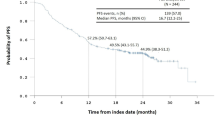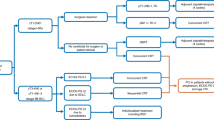Abstract
The aim of this retrospective study was to evaluate the prognostic role of gross tumor volume (GTV) on survival of locally advanced NSCLC patients, regardless of TNM stage, and to analyze whether GTV and other radiotherapy (RT) parameters wre important for the development of lung toxicity. Thirty-two patients with locally advanced NSCLC (stage IIIA bulky/IIIB) treated with chemoradiotherapy were retrospectively analyzed. Patients received induction chemotherapy followed by combination treatment (27 patients) or induction chemotherapy followed by RT alone (5 patients). Thoracic RT consisted in 60 Gy, with standard fractionation and was the same for all 32 patients. Dose volume histograms were collected from the 3D treatment plans and GTV, planning target volume, mean lung dose, volume of lung receiving more than 20 Gy or more than 30 Gy were analyzed. Survival was significantly longer in patients with a GTV<100 cm3 compared with patients having GTV>100 cm3 (p=0.03). In a multivariate analysis only N-status and GTV were predictors of survival with a risk ratio of 0.51 and 0.62, respectively. Ten patients (31%) developed radiation pneumonitis grade 2 or higher. None of the RT parameters examined correlated significantly with the development of lung toxicity. In locally advanced NSCLC, GTV and N-status play a prognostic role even in patients at the same clinical stage and receiving a combination of chemo- and radiotherapy. This could imply a reassessment of the current staging system in patients with non-resectable NSCLC to better identify those patients who would benefit more from the combined treatment, despite its higher toxicity.
Similar content being viewed by others
References
Martel MK, et al. Volume and dose parameters for survival of nonsmall cell lung cancer patients. Radiother Oncol 1997;44:23–29.
Bradley JD, et al. Gross tumor volume, critical prognostic factor in patients treated with three-dimensional conformal radiation therapy for non-small-cell lung carcinoma. Int J Radiat Oncol Biol Phys 2002;52:49–57.
Etiz D, et al. Influence of tumor volume on survival in patients irradiated for non-small-cell lung cancer. Int J Radiat Oncol Biol Phys 2002;53:835–846.
Kwa SL, et al. Radiation pneumonitis as a function of mean lung dose: an analysis of pooled data of 540 patients. Int J Radiat Oncol Biol Phys 1998;42:1–9.
Hernando ML, et al. Radiation-induced pulmonary toxicity: a dose-volume histogram analysis in 201 patients with lung cancer. Int J Radiat Oncol Biol Phys 2001;51:650–659.
Isokangas OP, Joensuu H, Halme M, Jekunen A, and Mattson K. Paclitaxel (Taxol) and carboplatin followed by concomitant paclitaxel, cisplatin and radiotherapy for inoperable stage III NSCLC. Lung Cancer 1998;20:127–133.
Willner J, et al. Sequential chemo- and radiochemotherapy with weekly paclitaxel (Taxol) and 3D-conformal radiotherapy of stage III inoperable non-small cell lung cancer. Results of a dose escalation study. Lung Cancer 2001;32:163–171.
Willner J, Jost A, Baier K, Flentje M. A little to a lot or a lot to a little? An analysis of pneumonitis risk from dose-volume histogram parameters of the lung in patients with lung cancer treated with 3-D conformal radiotherapy. Strahlenther Onkol 2003;179:548–556.
Kaplan EL, Meier P. Nonparametric estimation from incomplete observations. J Am Statist Assoc 1958;53:457–481.
Cox DR. Regression models and life tables. J R Statist Soc 1966;34:187–220.
Pfister DG, et al. American Society of Clinical Oncology treatment of unresectable non-small-cell lung cancer guideline: update 2003. J Clin Oncol 2004;22:330–353.
Willner J, Baier K, Caragiani E, Tschammler A, Flentje M. Dose, volume, and tumor control prediction in primary radiotherapy of non-small-cell lung cancer. Int J Radiat Oncol Biol Phys 2002;52:382–389.
Werner-Wasik M, Xiao Y, Pequignot E, Curran WJ, Hauck W. Assessment of lung cancer response after nonoperative therapy: tumor diameter, bidimensional product, and volume. A serial CT scan-based study. Int J Radiat Oncol Biol Phys 2001;51:56–61.
Robnett TJ, et al. Factors predicting severe radiation pneumonitis in patients receiving definitive chemoradiation for lung cancer. Int J Radiat Oncol Biol Phys 2000;48:89–94.
Inoue A, et al. Radiation pneumonitis in lung cancer patients: a retrospective study of risk factors and the long-term prognosis. Int J Radiat Oncol Biol Phys 2001;49: 649–655.
Yamada M, Kudoh S, Hirata K, Nakajima T, Yoshikawa J. Risk factors of pneumonitis following chemoradiotherapy for lung cancer. Eur J Cancer 1998;34:71–75.
Segawa Y, et al. Risk factors for development of radiation pneumonitis following radiation therapy with or without chemotherapy for lung cancer. Int J Radiat Oncol Biol Phys 1997;39:91–98.
Tsujino K, et al. Predictive value of dose-volume histogram parmeters for predicting radiation pneumonitis after concurrent chemoradiation for lung cancer. Int J Radiat Oncol Biol Phys 2003;55:110–115.
Oetzel D, et al. Estimation of pneumonitis risk in three-dimensional treatment planning using dose-volume histogram analysis. Int J Radiat Oncol Biol Phys 1995;33:455–460.
Yorke ED, et al. Dose-volume factors contributing to the incidence of radiation pneumonitis in non-small-cell lung cancer patients treated with three-dimensional conformal radiation therapy. Int J Radiat Oncol Biol Phys 2002;54:329–339.
Martel MK, et al. Dose-volume histogram and 3-D treatment planning evaluation of patients with pneumonitis. Int. J Radiat Oncol Biol Phys 1994;28:575–581.
Graham MV, et al. Clinical dose-volume histogram analysis for penumonitis after 3D treatment for non-small cell lung cancer (NSCLC). Int J Radiat Oncol Biol Phys 1999;45:323–329.
Jenkins P, D’Amico K, Benstead K, Elyan S. Radiation pneumonitis following treatment of non-small-cell lung cancer with continuous hyperfractionated accelerated radiotherapy (CHART). Int J Radiat Oncol Biol Phys 2003;56:360–366.
Marks LB, et al. Physical and biological predictors of changes in whole-lung function following thoracic irradiation. Int J Radiat Oncol Biol Phys 1997;39:563–570.
Byhardt RW, et al. The influence of field size and other treatment factors on pulmonary toxicity following hyperfractionated irradiation for inoperable non-small cell lung cancer (NSCLC)—analysis of a Radiation Therapy Oncology Group (RTOG) protocol. Int J Radiat Oncol Biol Phys 1993;27:537–544.
Seppenwoolde Y, et al. Comparing different NTCP models that predict the incidence of radiation pneumonitis. Normal tissue complication probability. Int J Radiat Oncol Biol Phys 2003;55:724–735.
Roach M, 3rd, et al. Radiation pneumonitis following combined modality therapy for lung cancer: analysis of prognostic factors. J Clin Oncol 1995;13:2606–2612.
Author information
Authors and Affiliations
Corresponding author
Rights and permissions
About this article
Cite this article
De Petris, L., Lax, I., Sirzén, F. et al. Role of gross tumor volume on outcome and of dose parameters on toxicity of patients undergoing chemoradiotherapy for locally advanced non-small cell lung cancer. Med Oncol 22, 375–381 (2005). https://doi.org/10.1385/MO:22:4:375
Issue Date:
DOI: https://doi.org/10.1385/MO:22:4:375




